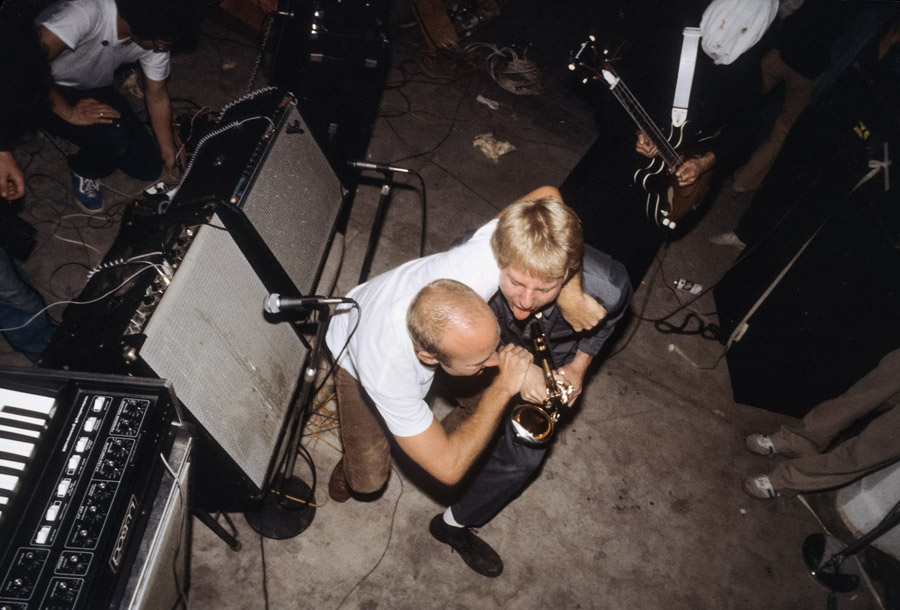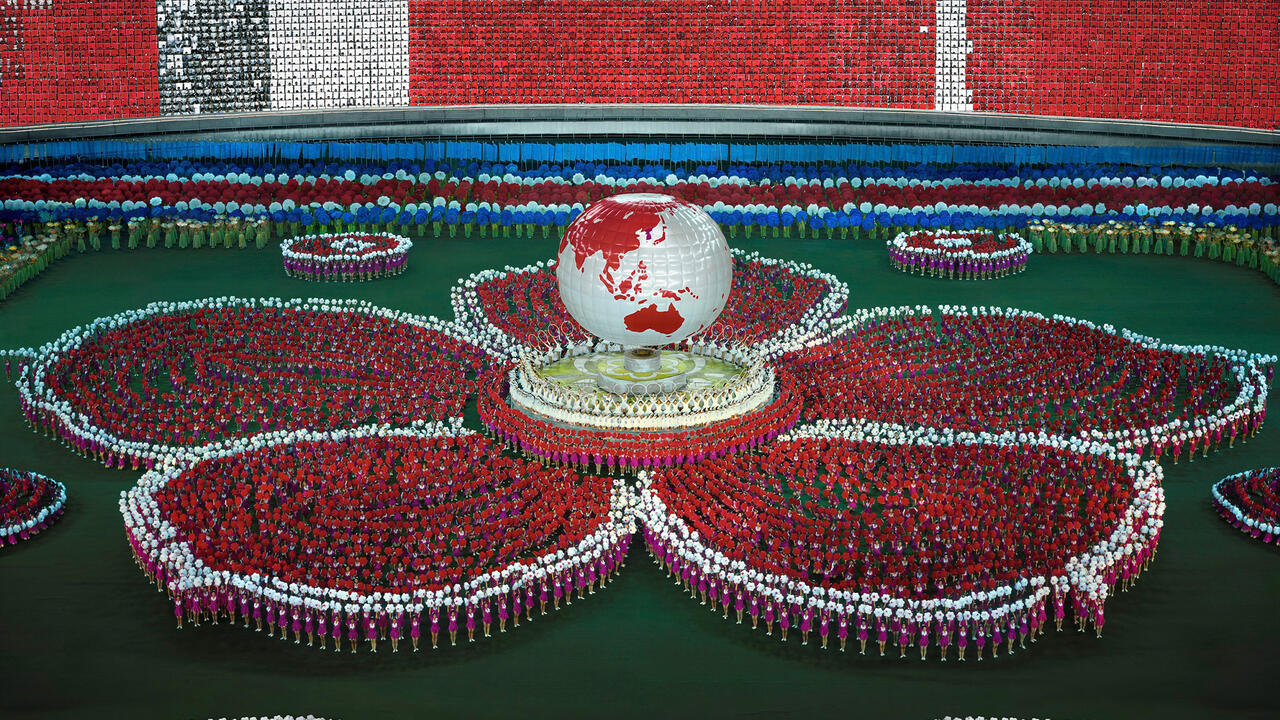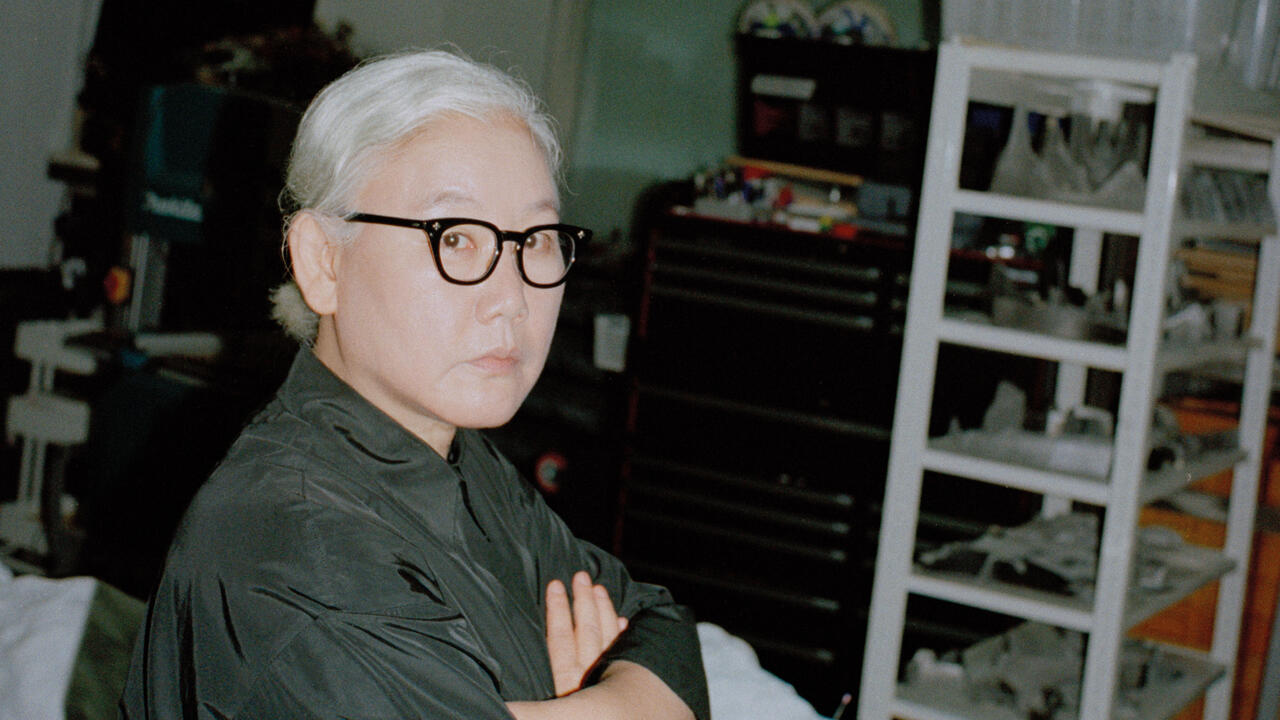The Rest Was Noise
Forty years of the Los Angeles Free Music Society
Forty years of the Los Angeles Free Music Society

‘We were about five minutes into our set and this big bouncer comes up and says, you have to go.’ Talking via Skype from his home in Los Angeles Joe Potts is recalling one of the shortest gigs in the turbulent history of the Los Angeles Free Music Society, at the Cathay de Grande in Hollywood in the early ’80s. ‘And we went, what? The owner says you have to go. So I said, OK, we’ll finish our set and go.’
The bouncer wasn’t having any of this. ‘You have to go now,’ he said, ‘or I’m just going to throw you and all your stuff out in that alley.’
‘I was doing record scratching with my wife’s grandfather’s 1920s portable Victrola,’ Potts recalls. ‘There was no way I wanted that thrown out in the alley. So I got the hell out of there.’
Was it because you were so loud?
‘I didn’t think we were …’
‘I was there,’ Fredrik Nilsen, sat on Potts’s right, chimes in. ‘It wasn’t that loud. It was just noise. Real noise.’

Today there is a recognized international noise music scene with its own literature, festivals, and even a popular web comic parodying the clichés of the genre. It has spawned PhDs and Subreddits and Village Voice lists of the 36 best noise tracks of the year. None of this existed in January 1976 when LAFMS organized their first concert in a decrepit multi-storey building in downtown Pasadena.
In the basement of the building was the studio of Paul McCarthy, where the artist was busy making films and doing bizarre things with ketchup and hotdog buns. Bruce Nauman worked just around the corner. On the ground floor was Poo Bah Records, the shop where Tom Recchion worked and many of the assorted musicians, artists, instrument-builders, and noise-makers that formed the LAFMS first met and started to play together.

They were far from the only people in the mid ’70s making music from noise. But their approach was unique, informed as much by the local performance art scene and Viennese Actionism as it was by the free improvisation of Derek Bailey and Evan Parker, the avant-rock of Captain Beefheart and Jimi Hendrix, the sound sculpture of Max Eastley and Hugh Davies.
‘We called it noise,’ Joe’s brother Rick Potts recalls, in a 2016 documentary about the group made by Holly Thompson and Mark McNeill, ‘because at the time, if you called it music, people would get in an argument with you.’ Today, the LAFMS are an acknowledged influence upon musicians as diverse as Sonic Youth, Hanatarash, and Pan Records boss Bill Kouligas. Over the last six years, festivals dedicated to their legacy have been convened in London, Gent, and Los Angeles. In the latter, at Mara McCarthy’s gallery The Box, a month-long celebration bringing together 40-years-worth of photographs, films, homemade instruments, artwork, and ephemera was convened last July. The complete recordings of the performances that took place during that exhibition have now been released as a deluxe 13 LP box set, LAFMS Box Box, complete with a 52-page full-colour book. From the blistering free noise of Airway to the squelchy plunderphonics of Dinosaurs With Horns to newer groups like Dolphin Explosion, formed in 2006 by two six year-old children with artist Mike Kelley on drums, the LAFMS Box Box is a wild and expansive collection, embodying an approach that Paul McCarthy (a member of LAFMS group Extended Organ since the mid ’90s) has termed the ‘LAFMS shoe.’
‘It’s whatever fits in the shoe,’ Fredrik Nilsen explains.
‘It is,’ Tom Recchion confirms, ‘a very big shoe.’

The first mention of something called the Los Angeles Free Music Society was on an application submitted in 1974 by the group Le Forte Four to the Høvikkoden Electronic Music Festival in Norway. Figuring that a name like Le Forte Four was unlikely to be taken seriously by so august an institution, the members of the group (principally the Potts brothers with Chip Chapman, then a student at Cal Arts under Morton Subotnick) opted for the East Los Angeles Free Music Society. Høvikkoden, regardless, remained unimpressed. ‘Free ears and minds are one thing,’ went the rejection letter, ‘but what about aesthetics?’
Tom Recchion read this story on the back of a record called Bikini Tennis Shoes, handed to him by Joe Potts at a private view the following year. ‘He was walking around the opening, carrying around a box of records, and giving them away,’ Recchion recalls. By that point, Recchion was already hosting ‘stoned-out jam sessions’ in the back of Poo Bah Records. He was familiar with Potts as a regular customer at the shop. ‘So the next time I saw Joe in the store,’ he recalls, ‘I said, I’ve got this group of people doing stuff too. Maybe we should join forces because there’s strength in numbers.’

‘The term “Free Music Society” started as a joke,’ Joe Potts confirms. But thanks to Recchion’s intervention it became ‘a means to unify several independent circles of mutual friends who were all experimenting with sound from a similar (non-)aesthetic viewpoint.’ Le Forte Four’s spastic mix of electronics, free reeds, and cultural detritus was augmented by the scattered percussion and demented chanting of Recchion and Harold Schroeder’s Doo-Dooettes, the drone-based freak-outs of Eric Stewart’s Smegma (‘the band without musicians’), and an almost uncountable number of other more-or-less temporary groupings, assembled on the fly from whoever happened to be around. New sounds and new means of making sounds were found by attaching hinges to the necks of guitars, putting bassoon reeds in the mouthpiece of trumpets, sticking nails and springs into hunks of wood, screwing and scrunching up found flexidiscs, and dropping things randomly to the floor. They soon became notorious, ‘a bunch of hoodlums,’ as one venue manager put it, whose performances would end in chaos, blown fuses, and ignominy. ‘I used to joke that we’ve played at every major art museum in southern California,’ Joe Potts told me, ‘but outside.’

After a relative lull in group activities in the mid- to late-’80s, today, the LAFMS are as active as they’ve ever been, with a haul of new releases and re-issues slated for this year and performances planned on three different continents. But for a long time they were marginalized and not taken seriously. ‘It was frustrating,’ Recchion says. ‘I had in my mind a connection to sound that would be like performance art. It felt no different to me. But it also didn’t feel that different to what a classical composer was doing who was exploring new music. So why couldn’t those things co-exist as a valid methodology for making work? What we do now is not really that different to what we were doing 40 years ago. It’s just that there is a world that understands sound art a lot more than it did back then. It’s a term now – universities have a curricular for sound art. That was not the case when I was going to art school. I stood out like a sore thumb.’
Le Forte Four’s ‘Bikini Tennis Shoes’ LP will be reissued on Etat-Unis, an imprint of Superior Viaduct, in March; Extended Organ’s ‘Vibe’, a new LP on Important Records, is expected this Spring. For more on the Los Angeles Free Music Society visit their website: www.lafms.com
Main image: The Doo-Dooettes, (l-r) Dennis Duck, Tom Recchion, Fredrik Nilsen, 1981. Courtesy: Fredrik Nilsen; photograph: © 1981 Mark Takeuchi



















